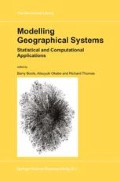Abstract
Recently, with the rapid progress in Geographical Information Systems (GIS) and their related fields, data previously unavailable can be analyzed using this powerful geographic tool. In addition, the use of GIS in economics, sociology, archaeology and human geography has expanded remarkably. There are, however, few studies which utilize GIS to analyze time-space phenomena. There is not only a difficulty in collecting the historical data due to the lack of statistical materials, but also there are high barriers to surmount in the process of transforming analog data to digital data (Knowles, 2000). On the other hand, topographical maps drawn at the end of the nineteenth century are effective for obtaining historical spatial data. Although these early edition maps do not meet the accuracy standard of contemporary survey, they do have many valuable characteristics: they cover wide areas, and they contain large amounts of information concerning regional circumstances at the time. It is also certain that the overall coordinate system of old topographical maps is somewhat biased, but this can be corrected through comparison with recent topographical maps. These observations motivated this paper, the objective of which is to estimate historical population distributions by linking topographical maps to statistical materials.
Access this chapter
Tax calculation will be finalised at checkout
Purchases are for personal use only
Preview
Unable to display preview. Download preview PDF.
References
Arai, Y. and S. Koike (2000), `BGSS Population estimation along BGSS system from Jinsokuzu Maps in the middle of the Meiji-Era in Chiba Prefecture.’ Komaba Studies in Human Geography, 14, 1–34 (in Japanese).
Haga, T. and M. Okabe (1992), Shashin de miru Edo Tokyo (Edo and Tokyo through photographs). Sinchosha, Tokyo (in Japanese).
Koike, S. and Y. Arai (2001) `BGSS population estimation from the topographical maps in the Meiji-Era.’ Theory and applications of GIS, 9 (1), 1–8 (in Japanese).
Knowles, A.K. (2000), `Introduction.’ Social Science History, 24, 451–470.
Kohno, K. (1990), `The Change of Central Place Systems in Nagano Basin from the Meiji-Era.’ Geographical Review of Japan Ser. A, 63, 1–28 (in Japanese).
Lee, J. (1996), `Redistributing the population: GIS adds value to historical demography.’ History and Computing, 8, 90–104.
Masai, Y. and S. Matsumoto (1971), `Cities and towns of Kanto district, Japan — Distributional appraisal of urban settlements in the Meiji, Taisho and Showa periods.’ Geographical Review of Japan, 44, 1–13 (in Japanese).
Morikawa, H. (1962), `Urban Areas distribution in the beginning of the Meiji-Era.’ The Human Geography, 14, 377–395 (in Japanese).
Murayama, Y. and H. Ono (1998), `Development of internet GIS — Map information system of regional statistics in the Meiji period.’ Tsukuba Studies in Human Geography, 22, 99–128 (in Japanese).
Nihon Chizu Sentah (Japan Map Center) and Kiinokiniya Shoten (1998), Meiji zenki sokuryo ni man gosen bun no ichi furansushiki saishoku chizu CD-ROM ban kaisetsusho. (Commentary of CD-ROM edition of French painted 1:20,000 scale maps in the beginning of the Meiji period).
Norton, W. (1976), `Constructing abstract worlds of the past.’ Geographical Analysis, 8, 269–288.
Okabe, A., H. Yomono and T. Kaneko (1984), `The accuracy of govarage estimation methods in relation to their amount of work.’ City Planning Review Extra Number, 19, 265–270.
Ono, M. (1956), `Again on the Quick-mastery and Temporary surveymap of Japan.’ The Human Geography, 8, 104–117 (in Japanese).
Siebert, L. (2000), `Using GIS to document, visualize, and interpret Tokyo’s spatial history.’ Social Science History, 24, 537–574.
Takasaki, M. (ed.) (1988), Chizugaku (Cartography). Asakura Shoten, Tokyo (in Japanese)
Taniuchi, T. (1995), `Distribution of urban population in the Tokyo and Osaka metropolitan areas, 1883–1985.’
The Proceedings of the Department of Humanities College of Arts and Sciences, 101,99–118 (in Japanese).
Author information
Authors and Affiliations
Editor information
Editors and Affiliations
Rights and permissions
Copyright information
© 2003 Springer Science+Business Media Dordrecht
About this chapter
Cite this chapter
Arai, Y., Koike, S. (2003). Grid-Based Population Distribution Estimates from Historical Japanese Topograhical Maps Using GIS. In: Boots, B., Okabe, A., Thomas, R. (eds) Modelling Geographical Systems. The GeoJournal Library, vol 70. Springer, Dordrecht. https://doi.org/10.1007/978-94-017-2296-4_12
Download citation
DOI: https://doi.org/10.1007/978-94-017-2296-4_12
Publisher Name: Springer, Dordrecht
Print ISBN: 978-90-481-6104-1
Online ISBN: 978-94-017-2296-4
eBook Packages: Springer Book Archive

